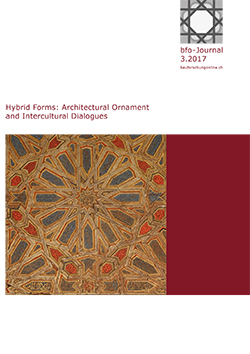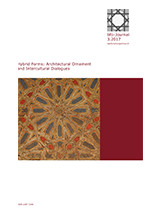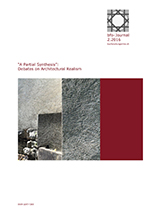bfo-Journal 3.2017

bfo-Journal 3.2017
Hybrid Forms: Architectural Ornament
and Intercultural Dialogues
Download complete volume
Editorial
Ariane Varela BragaDownload PDF
Formes hybrides dans l’espace médio-rhodanien au XIIe-XIIIe siècle
Nicolas Reveyron
Materialwechsel und Formtransfer. Hybridisierung in der aragonesischen Architektur des 16. Jahrhunderts
Caroline Helmenstein
Queequeg’s Coffin: A Conversation on Architecture and Ornament
Claire Zimmerman, with Jim Cogswell
bfo-Journal 3.2017
Abstracts
Formes hybrides dans l’espace médio-rhodanien au XIIe-XIIIe siècle
Nicolas Reveyron
Université Lumière-Lyon 2
L’hybridité fait partie de ces nouveaux paradigmes qui renouvellent l’histoire de l’art du Moyen Age occidental. L’épanouissement de la Renaissance XIIe à Lyon (2e moitié du XIIe siècle), l’insertion de citations byzantines, la transmission de cette formule hybride à Vienne dans la 1ère moitié du XIIIe siècle, puis l’irruption brutale d‘une stylistique gothique qui puise son inspiration dans divers modèles français, bourguignons et germaniques, illustrent la complexité de l’hybridité.
Materialwechsel und Formtransfer. Hybridisierung in der aragonesischen Architektur des 16. Jahrhunderts
Caroline Helmenstein
RWTH Aachen
Im Laufe des 16. Jahrhunderts hielten italienische Renaissanceformen auf der Iberischen Halbinsel Einzug und gingen mit den dort vorherrschen-den gotisch-mudéjaren Architekturformen eine Verbindung ein, aus der neue hybride Architekturelemente resultierten. Diesen Transferprozess spiegeln insbesondere die in Nordostspanien verbreiteten kunstvoll geschnitzten Holzgesimse anschaulich wider, an deren Beispiel der Form-wandel im vorliegenden Aufsatz nachvollzogen wird.
Queequeg’s Coffin: A Conversation on Architecture and Ornament
Claire Zimmerman, with Jim Cogswell
University of Michigan, Ann Arbor
Using digital imaging tools to ornament architecture, Jim Cogswell reframes two museum collections in his site-specific work Cosmogonic Tattoos (2017). By tattooing the glass surfaces of two museum buildings in a commissioned installation project, Cogswell repositions past and present in a complex array of hybridized images drawn off the collections. The iconography of the surface ornament derives from the contents of the buildings and the rhetorical space of their galleries. Valued holdings leach through to building surfaces in improbable scalar and iconographic combinations that juxtapose divergent artistic traditions from distant places. A visual essay and interview between the artist and architectural historian Claire Zimmerman, whose research has focused on the interpellation of architecture and images, this piece focuses on Cogswell’s combinatory analog and digital processes, and the de- and reconstruction of western institutions that his work undertakes.





